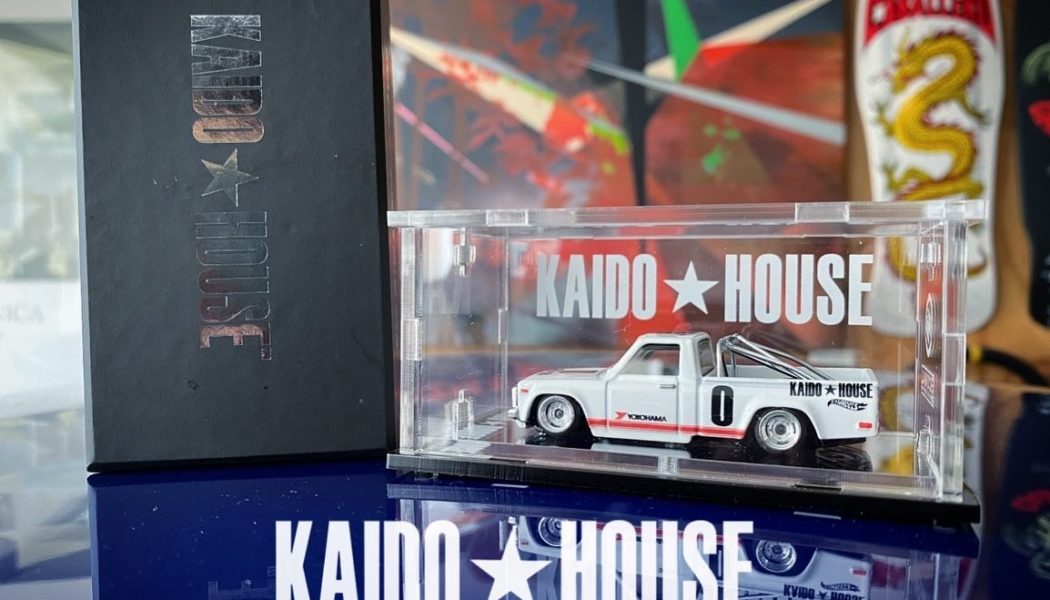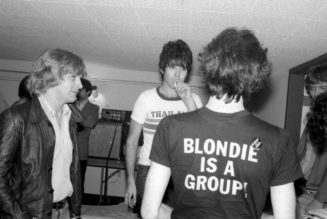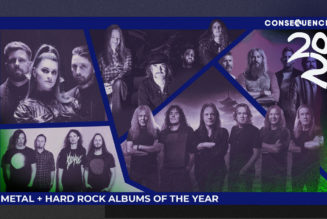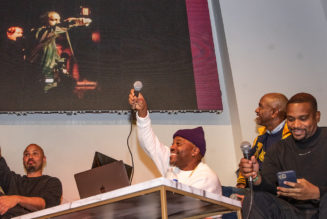Diecast car collecting has been around for over five decades, but in recent years has seen a pretty significant upswing—and with it a wave of customizers that pride themselves in dissecting and personalizing these 1/64-scale specimens. Meet Jun Imai, an artist, diecast customizing wizard, dedicated car enthusiast with an admitted obsession with Japanese cars of yesteryear, and probably one of the reasons that cool Hot Wheels you snatched off the shelf at your local Target while whispering “yesss!” to yourself even exist.
His Kaido House brand has become a source for hardcore diecast collectors to drool over and, when the stars align, actually get their hands on a one-off, entirely scratch-built custom. But for those who can’t, Kaido House has expanded with a line of offerings that bring the Imai’s vision to the masses.
Seed Planted
Based on the sorcery Imai applies to these tiny diecast creations, it’s only natural to assume he’s been a collector since childhood and eventually started customizing. In actuality, it was the radio controlled (R/C) world that pulled him in. At 5 years old, while living in Japan, Imai’s parents gifted him a Tomy Skyline Silhouette R/C car that never left his side. Countless AA batteries later, at age 11, his first hobby-grade R/C car came into the picture and he and his friends were hooked.
His fascination would turn to full-blown obsession after he received a Tamiya Blackfoot for his birthday—a car that he still owns to this day. He recalls, “That experience of assembling the kit from start to finish, painstakingly painting the body, applying all of the stickers, then doing that first wide-open throttle pass down the street sounds extremely familiar to us in the 1:1 world. Once you get into the option parts in R/C, it’s game over.”
Scaled Down Stress Relief
The urge to modify and improve is the heart and soul of R/C car building, that we know, but how did that translate to diecast cars?
“I rediscovered diecast cars while at Art Center College of Design,” Imai told us. “I was out looking for some inspiration for a car design project and happened to come across the Hot Wheels section at a local drugstore in Pasadena. I found one of my favorite cars, a ’64 Lincoln Continental. It was white with a red interior. I’ve always wanted to build a black ’64 Continental bagged on whitewalls, so I disassembled the Hot Wheels car and made it the way I wanted it.”
“That set off a feeling of accomplishment, satisfaction in a way, and scratched that customizing itch I couldn’t get to at school,” Imai continued. “Before Art Center, I’d built a ’93 Toyota pickup with a 4Runner front clip and Boyds billet wheels, but didn’t enjoy it much at school. I found more diecast cars I liked—a Mercedes 190E, Pikes Peak Celica, ’69 Chevy C10, and started cutting them up and having fun. It was a great way to blow off some steam from the stress of design. It’s interesting to think that after college and brief periods in the car studios, I’d end up working for Hot Wheels.”
Imai’s 14-year experience with Hot Wheels began as a temp designer and later saw him move all the way up to Director of Product Design. Surrounded by the diecast creations he loved and actually helped bring to the public for so many years, why leave a good thing?
“Working my way up the ladder to Director at Mattel was a crowning achievement in my career. I took pride in leading a world class design team and contributed to the product that earned the status as the number-one-selling toy in the world. I felt that I had gained all the expertise I could in diecast design. For myself, a personal fulfillment was made, and it was time to move on from a career perspective. I decided to go into a completely different field and pursue technology. I was tapped on the shoulder to enter the world of A.I. to build something that had never been done before—an autonomous race car series. I joined Roborace in the summer of 2018 as Product Director, and it was mind blowing. I had the experience of a lifetime with the group and am forever grateful. In 2020 I was invited to join a growing EV startup, Canoo, as Program Director and decided to join them. I’ve been working on some incredible vehicle projects there.”
In terms of career moves presented on a resume, all of the above make perfect sense, but there’s much more to Jun Imai’s urge to create. His personal brand, Kaido House has served as an outlet of sorts for his artistic automotive energy to spill over into something with essentially no boundaries, as he’s calling all of the shots for both his die-cast endeavors and his ever-expanding stable of full-size cars (like the turbo KA-swapped Datsun 510 wagon build you see below).
“A space with no limits. Kaido House challenges the status quo. Why do what everyone else is doing? It’s all about that character. I strive to have Kaido House projects drip with distinctive flavor and I try to apply this concept in every car project I do, which is why many of my builds take on a sort of unexplainable look that makes it ‘Kaido House.’ Now, the brand has a growing fan base which I am truly grateful for, along with several top tier auto and consumer product partners who see where the brand is going.”
The effort has resulted in close ties to industry staples, like GReddy Performance Products, where I met with Imai for an in-person look at just a sample of his incredible array of customs, the likes of which would be shipped to their lucky owners shortly after our meeting.
One-off Comes at a Cost
Each of these hand-crafted collectibles, which start life as a 3D model, are truly one-of-a-kind. There have been times when Imai put together a small batch of one particular style for Kaido House and various partners during special events, for example, but other than those, you won’t find any clones being offered and that exclusivity—along with his well-known otherworldly attention to detail—is why these customs sell quickly after they’ve been revealed via the Kaido House website. Like any hard-to-obtain collectible, total exclusivity comes at a price. It’s not unusual for one of Imai’s latest diecast art pieces to fetch a four-figure price. Previously, a waiting list was set up and at one point carried over 100 eager, committed buyers. Not content with having fans at the bottom of the list wait for so long, the “post and sell” model was instituted and seems to work much better.
Despite having painstakingly pieced together over 300 customs over the last two years, customization has never become robotic; Imai seems to rely on his gut rather than a set process. “I used to approach customs methodically, but now it is purely random and by feel. I don’t take requests from individuals as this limits expression. I believe this is a very different approach as I do not offer customization as a service. It is rather a creative outlet for myself and my ideas. I view a diecast car as a blank canvas full of creative freedom. I can cut, grind, paint, and detail to whatever style I am feeling at that moment. Recently I have been experimenting with weathering and patina, and I call these works the DESTROY series. These are great fun as there is no planning, only full commitment with paints, brushes, and an airbrush. I often get lost in this process, in a good way. Doing decals and clearcoat in a pristine execution is an appreciated skill, but that can get boring. I much prefer to freestyle and build with no end target.”
Customs for Everyone
Of course, not everyone has the sort of scratch to score a Kaido House original, and that’s what makes Imai’s latest endeavor that much more interesting. He explains, “I’m proud to launch an all-new diecast product line with my partnership with Mini GT. Our first release, an all-new Pro Street Datsun 510, is taking the diecast world by storm with many firsts, such as the first to use alloy wheels on a mass produced 1:64 diecast car, and the unique finishes on the chassis. When you pop the hood of the Pro Street 510, you’ll see the exact same GReddy KA24DET that was built for my wagon, along with the distinctive livery that appeared on my wagon almost 10 years ago. And when was the last time you saw a Pro Street 510 in 1:64 diecast, slammed on Japanese four-spokes and a turbo-4? This is the Kaido House way.”
Essentially the next step in Imai’s diecast journey, the Datsun 510 project with Mini GT represents a piece of Kaido House creativity for everyone. “It’s a very different product than my [one-of-one] customs, but it definitely creates an opportunity for fans to own a distinctive product that’s a bit easier to add to their collections. It offers a premium, Kaido House designed and branded product at a very competitive price point and with a high level of content.”
Second Chance
The overwhelming response and number of pre-sales for the initial run of Datsun 510 Pro Street models with Mini GT went well beyond what Imai was anticipating. But not to worry, there’s another release on the horizon. “The second release will be announced soon and that one will be a drop no one should miss. You’ll all see why soon. Stay tuned on my IG’s, @kaidohouse and @kaidohousegarage (diecast specific) for more details on when they’ll drop and where you can get them. Also, stay up on minigt.com and kaidohouse.com for all of the details as well.”










